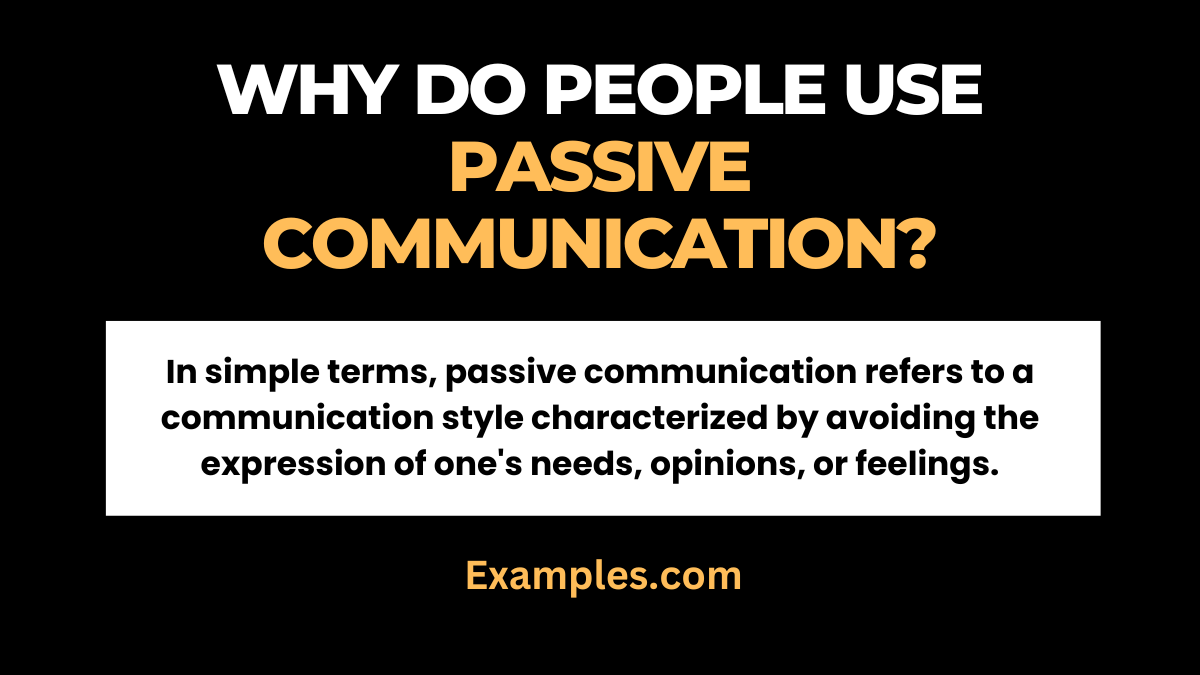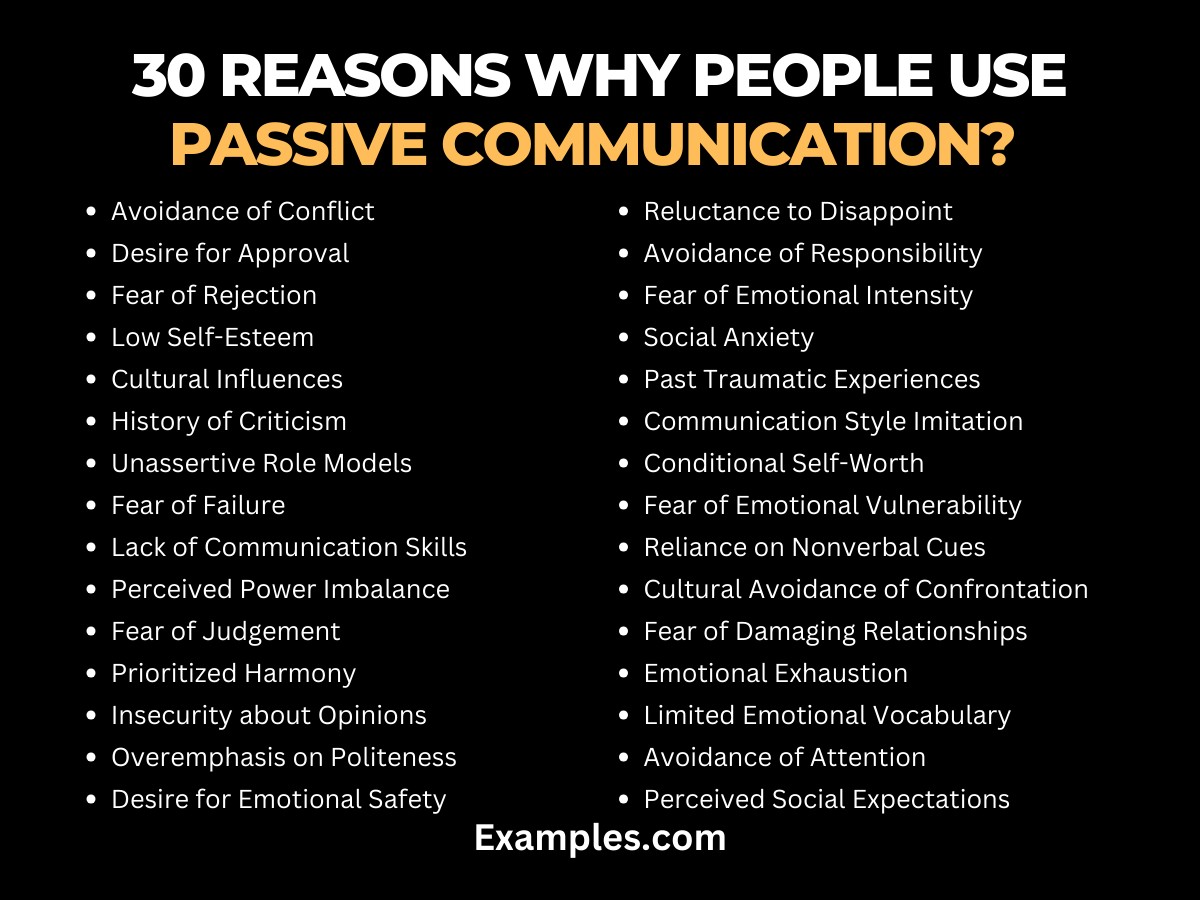Why do People use passive communication?
Embark on a journey to understand the intricate motives behind the adoption of passive communication. This comprehensive guide explores the myriad Communication Examples that shed light on why individuals choose passivity. Dive into real-world scenarios, expert insights, and practical explanations to decode the reasons behind this communication style. Gain valuable perspectives and strategies to navigate the complexities of passive communication effectively.
Why Do People Use Passive Communication? – Definition

In simple terms, passive communication refers to a communication style characterized by avoiding the expression of one’s needs, opinions, or feelings. Individuals employing passive communication often prioritize avoiding conflict, seeking approval, and minimizing confrontation. This communication approach can lead to unspoken frustrations and misunderstandings. Understanding the reasons behind choosing passive communication is crucial for effective interpersonal dynamics and fostering more assertive expressions.
30 Reasons Why People Use Passive Communication?
Passive communication, a subtle yet impactful style, stems from a myriad of deeply rooted motives. Understanding these reasons provides a key to unravelling the complexities that drive individuals towards passivity in their interactions.

- Avoidance of Conflict: Individuals opt for passivity to sidestep potential conflicts, prioritizing relationship harmony over confrontation.
- Desire for Approval: Seeking approval becomes a driving force, leading individuals to align with others’ expectations through passive communication.
- Fear of Rejection: The fear of rejection prompts individuals to express themselves passively, avoiding potential criticism and preserving self-esteem.
- Low Self-Esteem: Passivity becomes a coping mechanism for those with low self-esteem, shielding themselves from perceived judgment.
- Cultural Influences: Cultural backgrounds shape passive tendencies, emphasizing politeness and indirectness in communication.
- History of Criticism: Past experiences of criticism may instigate the adoption of passive communication as a defence mechanism.
- Unassertive Role Models: Growing up with unassertive role models influences the development of passive communication patterns.
- Fear of Failure: The fear of failure drives individuals towards passivity, attempting to minimize potential setbacks.
- Lack of Communication Skills: Insufficient communication skills may lead individuals to choose passivity as an alternative means of navigating social interactions.
- Perceived Power Imbalance: In situations with perceived power imbalances, individuals may resort to passivity to avoid conflict with authority figures.
- Fear of Judgement: The apprehension of being judged looms large, prompting passive communication to keep individuals in the shadows.
- Prioritized Harmony: Valuing harmony over individual expression leads some to choose passive communication to maintain peaceful relationships.
- Insecurity about Opinions: Uncertainty about the validity of personal opinions may lead to passivity to avoid potential disagreement.
- Overemphasis on Politeness: Cultural norms emphasizing politeness encourage individuals to express themselves passively to avoid perceived rudeness.
- Desire for Emotional Safety: Passive communicators prioritize emotional safety, steering clear of situations that may trigger discomfort.
- Reluctance to Disappoint: The reluctance to disappoint others motivates passive communication, as individuals strive to meet expectations.
- Avoidance of Responsibility: Passivity may be a way to deflect responsibility, particularly in challenging or decision-making situations.
- Fear of Emotional Intensity: An aversion to emotional intensity may lead individuals to opt for passive communication to avoid heightened emotions.
- Social Anxiety: Individuals grappling with social anxiety may resort to passive communication as a coping mechanism in social interactions.
- Past Traumatic Experiences: Traumatic experiences in the past can instigate passive communication as a protective response.
- Communication Style Imitation: Adopting the communication style of peers or role models may lead to passive expression unconsciously.
- Conditional Self-Worth: Relying on external validation for self-worth can drive individuals to choose passive communication to garner approval.
- Fear of Emotional Vulnerability: Passivity may serve as a shield against exposing emotional vulnerability, ensuring a perceived sense of control.
- Reliance on Nonverbal Cues: Some individuals lean towards passive communication by relying on nonverbal cues rather than explicit verbal expression.
- Cultural Avoidance of Confrontation: In cultures that discourage confrontation, individuals may adopt passive communication to align with societal norms.
- Fear of Damaging Relationships: The fear of damaging relationships prompts individuals to opt for passive communication to maintain connections.
- Emotional Exhaustion: Emotional exhaustion may lead individuals to choose passivity as a way to conserve emotional energy.
- Limited Emotional Vocabulary: A limited emotional vocabulary can result in passive communication as individuals struggle to articulate complex feelings.
- Avoidance of Attention: Preferring to stay under the radar, individuals may choose passive communication to avoid unwanted attention.
- Perceived Social Expectations: Conforming to perceived social expectations can drive individuals towards passive communication to fit in.
motivations, from fear of judgment to cultural influences. Acknowledging these reasons empowers individuals to navigate their communication styles consciously. By understanding the roots of passive expression, we pave the way for fostering empathy and cultivating more assertive and authentic interactions. This comprehensive guide sheds light on the complexities, offering insights for a transformative journey towards effective and meaningful communication.



